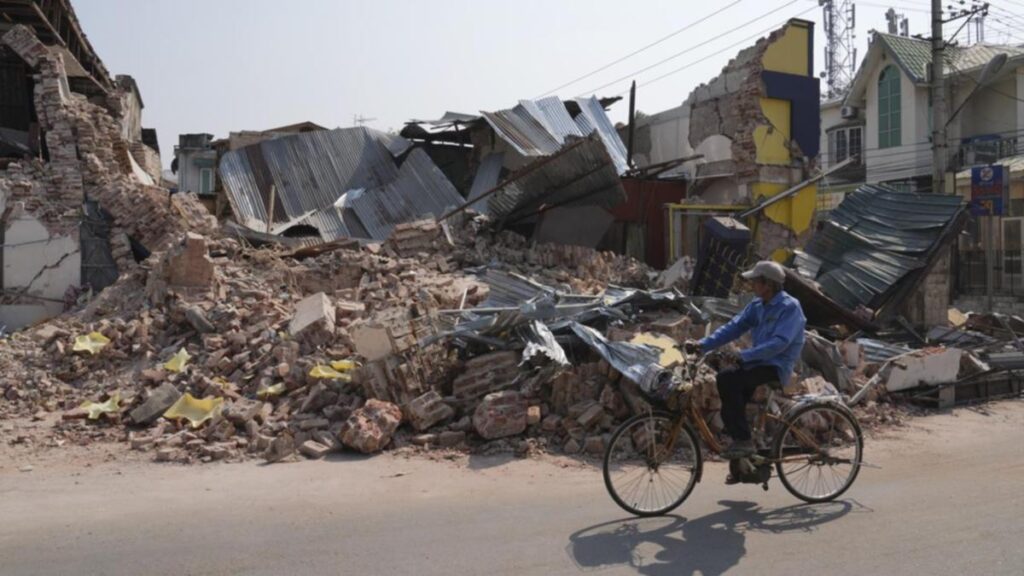An armed resistance movement against Myanmar’s military-run government has criticised the junta for conducting air strikes on villages even as the country reels from an earthquake that has killed some 1700 people.
The toll from Myanmar’s earthquake continued to rise on Sunday, as foreign rescue teams and aid rushed into the impoverished country, where hospitals were overwhelmed and some communities scrambled to mount rescue efforts with limited resources.
The 7.7-magnitude quake, one of Myanmar’s strongest in a century, jolted the war-torn Southeast Asian nation on Friday, leaving around 1700 people dead, 3400 injured and more than 300 missing as of Sunday, the military government said.
The Karen National Union, one of Myanmar’s oldest ethnic armies, said in a statement that the junta “continues to carry out air strikes targeting civilian areas, even as the population suffers tremendously from the earthquake”.
The group said that under normal circumstances, the military should be prioritising relief efforts, but instead is focused on “deploying forces to attack its people”.
A spokesman for the junta did not reply to queries from Reuters about the criticism.
Myanmar has been locked in civil war with multiple armed opposition groups since a 2021 coup, when the military seized power from the elected government of Nobel Peace Prise laureate Aung San Suu Kyi.
Shortly after Friday’s devastating earthquake, military jets launched air strikes and drone attacks in Karen state, near the KNU headquarters, according to the Free Burma Rangers, a relief organisation.
The epicentre of the quake was in an area held by junta forces, but the devastation is widespread and also affected some territory held by armed resistance movements.
On Sunday, the opposition National Unity Government, which includes remnants of the government ousted in 2021, said anti-junta militias under its command would pause all offensive military action for two weeks.
Richard Horsey, the senior Myanmar adviser at Crisis Group, said some anti-junta forces have halted their offensives but fighting continues elsewhere.
“The regime also continues to launch air strikes, including in affected areas. That needs to stop,” he said.
He added that the regime was not providing much visible support in quake-hit areas.
“Local fire brigades, ambulance crews, and community organisations have mobilised, but the military – who would normally be mobilised to support in such a crisis – are nowhere to be seen,” Horsey said.
The junta chief, Senior General Min Aung Hlaing, warned that the number of fatalities could go up and his administration faced a challenging situation, state media reported, three days after he made a rare call for international assistance.
India, China and Thailand are among Myanmar’s neighbours that have sent relief materials and teams, along with aid and personnel from Malaysia, Singapore and Russia.
“The destruction has been extensive, and humanitarian needs are growing by the hour,” the International Federation of Red Cross and Red Crescent Societies said in a statement.
“With temperatures rising and the monsoon season approaching in just weeks, there is an urgent need to stabilise affected communities before secondary crises emerge.”
Critical infrastructure – including bridges, highways, airports and railways – across the country of 55 million lie damaged, slowing humanitarian efforts.
In some areas near the epicentre, residents told Reuters that government assistance was scarce, leaving people to fend for themselves.
In Mandalay, scores of people were feared trapped under collapsed buildings and most could not be reached or pulled out without heavy machinery, two humanitarian workers and two residents said.
“My teams in Mandalay are using work gloves, ropes and basic kits to dig and retrieve people,” said one of the humanitarian workers. Reuters is not naming them because of security concerns.
“There are countless trapped and still missing. The death toll is impossible to count at the moment.”
In Bangkok, at the site of the collapsed 33-storey building, rescuers surrounded by shattered concrete piles and twisted metal continued their efforts to rescue dozens of workers trapped under the rubble.
Teerasak Thongmo, a Thai police commander, said his team of policemen and rescue dogs were racing against time to locate survivors, struggling to move around metal debris and sharp edges on an unstable structure.
“Right now, our team is trying to find anyone that might still be alive. Within the first 72 hours, we have to try and save those still alive,” he said.



